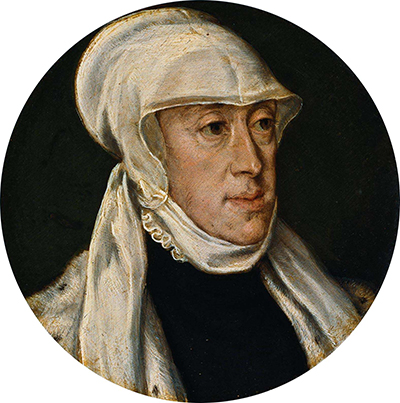Titian's portrait of Mary of Hungary, Regent of the Netherlands, exists now only in two virtually identical versions painted by unknown 16th century artists.
One oil on canvas version can be found in the Musée des Arts Décoratifs, Paris, the other, on board, in the Rijksmuseum, Amsterdam. At first, the portrait appears to be an extraordinarily honest painting of a middle-aged woman, whose nun-like black robe, white wimple and modestly covered head betray nothing of her celebrated family, nor the authoritative role she played in 16th century politics for nearly three decades. Further examination, however, reveals subtle clues that distinguish this masterful portrait from other superficially similar images of Mary, such as that by the Master of the Legend of the Magdalen.
Her widow's robe may be plain, but it is collared in ermine-like fur, symbol of royalty and statesmanship. The finest lace wraps tightly round her wrists. Her head-dress is more than a simple coif like those worn by the unassuming wives of wealthy citizens. The widow's hood peaks forward slightly, giving the impression of a helmet, with the gorget-like wimple adding to the illusion of armour. Sister of the Holy Roman Emperor Charles V, Mary of Hungary (1505 - 1558) was entrusted with the role of Regent of the Low Countries after the death of her beloved husband Louis II of Hungary at the Battle of Mohács.
The distinctive jutting chin of the family, which became the epitome of imperial determination in Titian's famous equestrian portrait of Charles V, in Mary of Hungary becomes a metaphor for the futility she herself appears to have felt in the role of Regent. Her large, sorrowful eyes looking away from the observer tell the truth about her circumstances, her distaste for the responsibilities of the work and her constant wish to be freed of it.
Despite criticisms of her character, her alleged sympathy for the Lutheran cause, and her actions, she was clearly too valuable a deputy for Charles to remove. It is hard to reconcile the Mary of this portrait, with other, youthful, but perhaps more flattering images said to represent her. In the portrait painted by Hans Maler zu Schwaz when she was fifteen, she appears as a genuine belle, dressed in red and gold, with fashionably decorated hat. This is the Mary of Hungary who also loved music, art and hunting, who met with Ippolito d’Este and other members of the European elite.
Portraiture mattered at this time, portraits being the equivalent of a social media avatar. They needed to show the subject in a good, but not too unrealistic light. Mary herself was involved in the choice of portrait of her nephew, Philip of Spain, to be sent to England as part of the marriage negotiations with Queen Mary. After some debate, one was finally chosen, with concern over the decision. Mary of Hungary's own frank portrait, a copied reflection of the genius of Titian, is an honest record of her lifelong burden.




